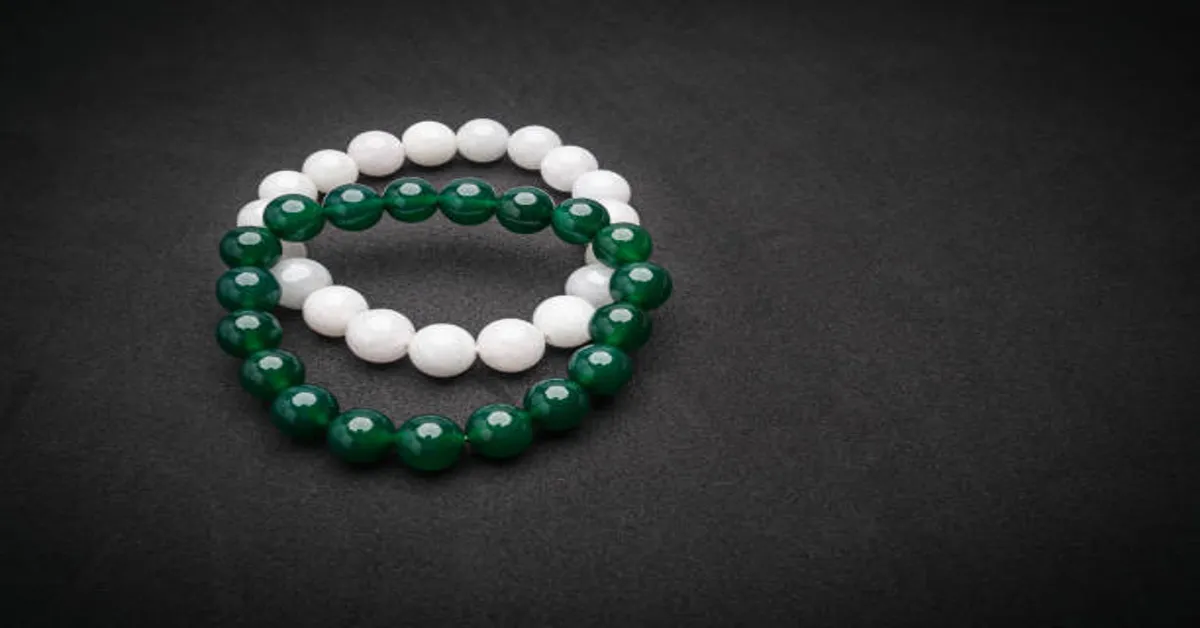Jewelry has held symbolic and functional significance for humans across all civilizations, and among the many stones revered throughout history, jade has maintained a unique place in both fashion and spiritual traditions. Whether worn as a personal ornament or given as a meaningful gift, a jade bracelet carries more than just decorative value. It represents cultural heritage, spiritual beliefs, healing energies, emotional balance, and even economic value. The jade bracelet, often passed down through generations, symbolizes continuity, strength, protection, and well-being.
In this detailed and informative article, we will explore everything you need to know about jade bracelets—from their historical significance to their modern-day uses, including how to choose one, their healing attributes, the meaning of different colors, maintenance tips, and what makes them a timeless addition to any collection of meaningful jewelry.
What Is Jade?
Before diving into the specifics of a jade bracelet, it is essential to understand what jade is. The term “jade” refers to two different minerals—jadeite and nephrite—which, although similar in appearance, have distinct chemical compositions and physical properties. Jadeite is the rarer and more valuable variety and is often found in vivid green shades. Nephrite is more common and is known for its slightly softer and waxier appearance.
Both types have been used for thousands of years to craft tools, ornaments, and jewelry, but it is jadeite, particularly of the “imperial green” quality, that is prized in high-end jewelry markets. Jade is most commonly associated with East Asian cultures, but it has been appreciated and utilized by civilizations in Mesoamerica, New Zealand, and ancient Europe as well.
Historical and Cultural Significance of Jade Bracelets
The jade bracelet carries immense cultural importance, particularly in Chinese culture, where jade has long been regarded as the “Stone of Heaven.” For thousands of years, jade has symbolized virtues such as purity, loyalty, compassion, and wisdom. Emperors wore jade amulets to connect with divine energy, and families passed down jade jewelry to preserve ancestral blessings and protection.
In traditional Chinese society, gifting a jade bracelet to a daughter or bride was common, symbolizing love, protection, and the transmission of family values. Jade was believed to absorb negative energy and prevent harm. If a jade bracelet cracked or broke, it was said to have taken the brunt of misfortune, shielding its wearer from harm.
In Maya and Aztec civilizations, jade was considered more precious than gold. It was often buried with the dead as a token for the afterlife, reflecting the belief in jade’s power to bring spiritual continuity. In Maori culture of New Zealand, nephrite jade (also called “pounamu” or greenstone) is carved into intricate forms and passed on as heirlooms, representing strength, status, and ancestry.
Thus, jade bracelets are not just ornamental accessories; they are deeply interwoven with values, beliefs, and historical continuity that transcends generations and geography.
Symbolism and Meaning of Jade Bracelets
Wearing a jade bracelet is often thought to bring harmony, prosperity, and good fortune. The meanings associated with jade are as rich as the cultures that venerate it. While interpretations may vary, some universally accepted symbols and themes include:
- Protection: Jade is believed to form an energetic shield, warding off negative influences or harmful forces. Many believe the bracelet acts as a spiritual guard for the person wearing it.
- Health and Longevity: In traditional Chinese medicine, jade is associated with health and the balance of vital energy, or “chi.” The stone is thought to support kidney health and the cleansing of bodily systems.
- Prosperity and Abundance: Jade is considered a stone of wealth. It is often worn by businesspeople or individuals seeking financial stability and opportunities.
- Emotional Harmony: Jade is also said to calm the mind and promote emotional well-being. It soothes irritability and fosters balance and patience.
- Spiritual Awakening: For many, jade helps align physical and spiritual energies, enabling a deeper connection with one’s higher self or spiritual guide.
The circular shape of a jade bracelet also carries deep symbolism. In many cultures, a circle represents completeness, eternity, and the cyclical nature of life. Thus, the shape and material together make a jade bracelet a powerful item of symbolism and spiritual function.
The Healing Properties of Jade Bracelets
Whether you believe in crystal energy or not, countless individuals attest to the therapeutic effects of wearing jade. Crystal healing is an ancient practice that involves using specific stones to influence the energy centers (chakras) of the body. Jade, particularly when worn on the wrist where major pulse points and energy lines are located, is said to influence both emotional and physical wellness in the following ways:
- Detoxification: Jade is linked with supporting kidney and adrenal function, encouraging the body’s natural detox processes.
- Heart Health: By calming the nervous system and reducing stress, jade may indirectly benefit cardiovascular health.
- Calmness and Peace: Many people experience greater inner peace when wearing jade. It is said to help release anger and promote forgiveness.
- Chakra Alignment: Green jade is most closely aligned with the heart chakra, aiding in love, compassion, and emotional healing.
Though scientific validation of crystal healing remains limited, many people report subjective improvements in their mental and emotional state when regularly wearing jade jewelry.
Types of Jade Bracelets
Jade bracelets come in several styles, each catering to different preferences and symbolic interpretations. The main types include:
1. Solid Bangle Bracelets
These are carved from a single piece of jade and are circular in form. This is the most traditional form in East Asian cultures. They are often tight-fitting and worn continuously.
2. Hinged or Open Cuff Bracelets
These are more modern and user-friendly variations that can be adjusted to fit the wrist more comfortably. They often combine jade with metals like silver or gold.
3. Beaded Bracelets
Jade beads are strung together using elastic, silk thread, or metal wire. These are easy to wear and often come with added charms or other stones.
4. Carved Jade Bracelets
Some jade bangles are intricately carved with symbols such as dragons, phoenixes, lotus flowers, or Buddhist symbols, adding layers of meaning to the piece.
Colors of Jade and Their Meanings
While green is the most commonly recognized color, jade comes in many natural shades. Each color is associated with different energies and interpretations:
- Green Jade: Represents balance, harmony, and abundance. It is the most popular and spiritually potent form.
- White Jade: Known for purity, calmness, and clarity. Often used for meditation and peaceful intentions.
- Lavender Jade: Symbolizes spiritual growth, inner peace, and emotional healing.
- Yellow Jade: Connected with joy, optimism, and clarity of thought. Said to stimulate personal energy and vitality.
- Black Jade: Offers strong protection against negativity and physical harm. Often worn by travelers or those in high-risk environments.
- Red Jade: Encourages courage, vitality, and passion. Stimulates the base chakra and enhances life force.
How to Choose the Right Jade Bracelet
When selecting a jade bracelet, there are several factors to consider beyond appearance. These include:
- Authenticity: Genuine jade can be expensive, especially jadeite. Be wary of imitations made of glass or dyed stones. Reputable sellers should provide certification.
- Fit: Traditional jade bangles should fit snugly but not so tightly that it’s painful. The bracelet should slide over the hand but rest gently on the wrist.
- Color Preferences: Choose a color that resonates with your energy or intentions. Lighter shades are calming, while darker ones are more protective.
- Transparency and Texture: High-quality jade often has a smooth, glassy texture and some degree of translucency. Opaque jade is more common but less valuable.
- Symbolism: Consider any carvings, symbols, or charms added to the bracelet and what they mean to you personally.
How to Wear and Care for Your Jade Bracelet
Wearing Your Bracelet
Jade bracelets can be worn on either wrist, though in Chinese tradition, the left wrist is preferred as it is believed to be the receiving side of the body—absorbing the protective and healing energy of the stone. Many choose to wear their jade bracelet continuously, allowing it to tune to their body’s energy over time.
It’s common for a new jade bracelet to feel “cool” at first. Over time, it warms up with body heat, symbolizing the connection between stone and wearer. In fact, many people report that their bracelet becomes more translucent or vibrant with prolonged wear.
Caring for Jade
Despite its tough appearance, jade should be handled with care. Here are some tips for maintaining its natural beauty:
- Avoid Harsh Chemicals: Keep it away from perfumes, alcohol, and household cleaning products.
- Clean Gently: Use warm water and a soft cloth. Avoid abrasive materials or ultrasonic cleaners.
- Store Safely: Store it in a soft pouch or padded box, separate from other jewelry to prevent scratches.
- Check for Cracks: While jade is hard, it can crack under pressure or if dropped. Examine your bracelet regularly for any damage.
Modern-Day Appreciation and Gifting Traditions
Today, jade bracelets are worn by people all over the world for a blend of aesthetic, spiritual, and cultural reasons. They are popular gifts during life milestones such as:
- Birthdays and Coming-of-Age Ceremonies
- Weddings and Engagements
- Mother’s Day or New Year Celebrations
- Graduations or Career Achievements
- As a Heirloom Passed Down Generations
Such gifts carry more than monetary value—they represent care, protection, and blessing. In some modern spiritual circles, jade bracelets are worn as part of mindfulness and meditation practices, further enhancing their modern relevance.
ALSO READ: Crystal Boba: A Detailed Exploration of This Unique Chewy Delight
5 Frequently Asked Questions (FAQs)
1. What is the spiritual meaning of wearing a jade bracelet?
Wearing a jade bracelet symbolizes harmony, protection, health, and prosperity. It is believed to shield the wearer from harm and attract positive energy while promoting inner peace and emotional balance.
2. Can I wear a jade bracelet every day?
Yes, jade bracelets are designed to be worn daily. Many people believe that continuous wear allows the stone to synchronize with the wearer’s energy, enhancing its healing and protective properties over time.
3. How can I tell if a jade bracelet is real or fake?
Authentic jade feels cool to the touch, has a dense, smooth texture, and may show natural patterns. To be sure, look for a certificate of authenticity or have the stone tested by a gemologist.
4. Which wrist should I wear my jade bracelet on?
Traditionally, jade is worn on the left wrist, which is considered the body’s receptive side in Chinese energy beliefs. However, it’s also a matter of personal comfort and intention.
5. What does it mean if my jade bracelet breaks?
Culturally, a broken jade bracelet is seen as a sign that it has absorbed negative energy or protected the wearer from harm. It is often viewed not as a loss but as a protective sacrifice.









